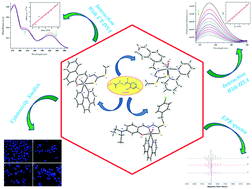Synthesis, structure and characterization of new dithiocarbazate-based mixed ligand oxidovanadium(iv) complexes: DNA/HSA interaction, cytotoxic activity and DFT studies†
Abstract
Three new mixed-ligand oxidovanadium(IV) complexes [VIVOL1–2(LN–N)] (1–3) have been synthesized using two tridentate bi-negative –ONS chelating dithiocarbazate ligands, H2L1-2, where H2L1 = S-methyl 3-(2-hydroxynaphthyl)methylenedithiocarbazate, and H2L2 = 4-chloro-S-benzyl 3-(2-hydroxy-4-diethylaminophenyl)methylenedithiocarbazate and neutral N,N-donor bases (LN–N) like 1,10-phenanthroline (phen) (1 and 2) and 2,2′-bipyridine (bipy) (3) as a co-ligand. All the ligands and their corresponding metal complexes have been successfully characterized using several physicochemical (elemental analysis), spectroscopic (UV-vis, IR and EPR), spectrometric (ESI-MS) and electrochemical (cyclic voltammetry) methods. The geometry of the complexes was determined by X-ray diffraction analysis and also optimized using density functional theory (DFT) calculations, which revealed that the compounds possess a distorted octahedral geometry with tridentate dianionic L1-2 in the meridional arrangement and bidentate co-ligand LN–N with an equatorial–axial coordination. To evaluate the biological activity of the oxidovanadium(IV) species, their interactions with calf thymus-DNA (CT-DNA) and human serum albumin (HSA) were studied through UV-vis absorption titration and fluorescence spectral methods. The results indicated that all the complexes have moderate binding affinity towards both DNA and HSA. Finally, the in vitro antiproliferative activity of all the complexes was evaluated against human cervical cancer (HeLa) and mouse embryonic fibroblast (NIH-3T3) cell lines by MTT assay and the results suggested that the complexes were significantly active compared to various clinically reported drugs.



 Please wait while we load your content...
Please wait while we load your content...